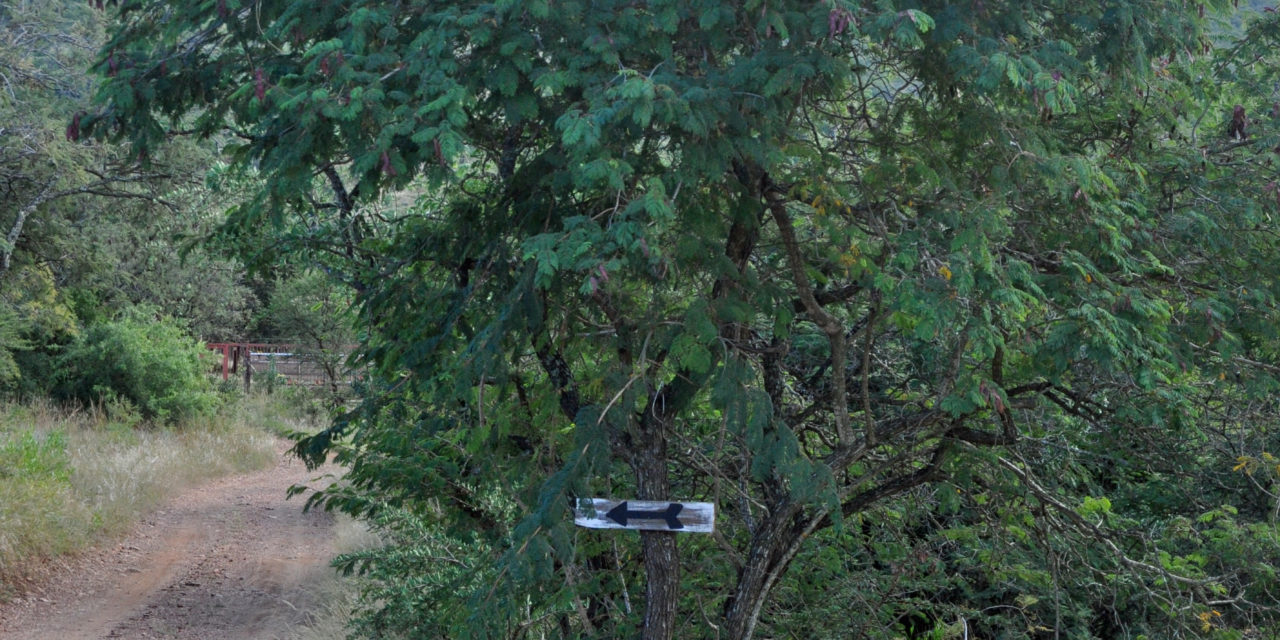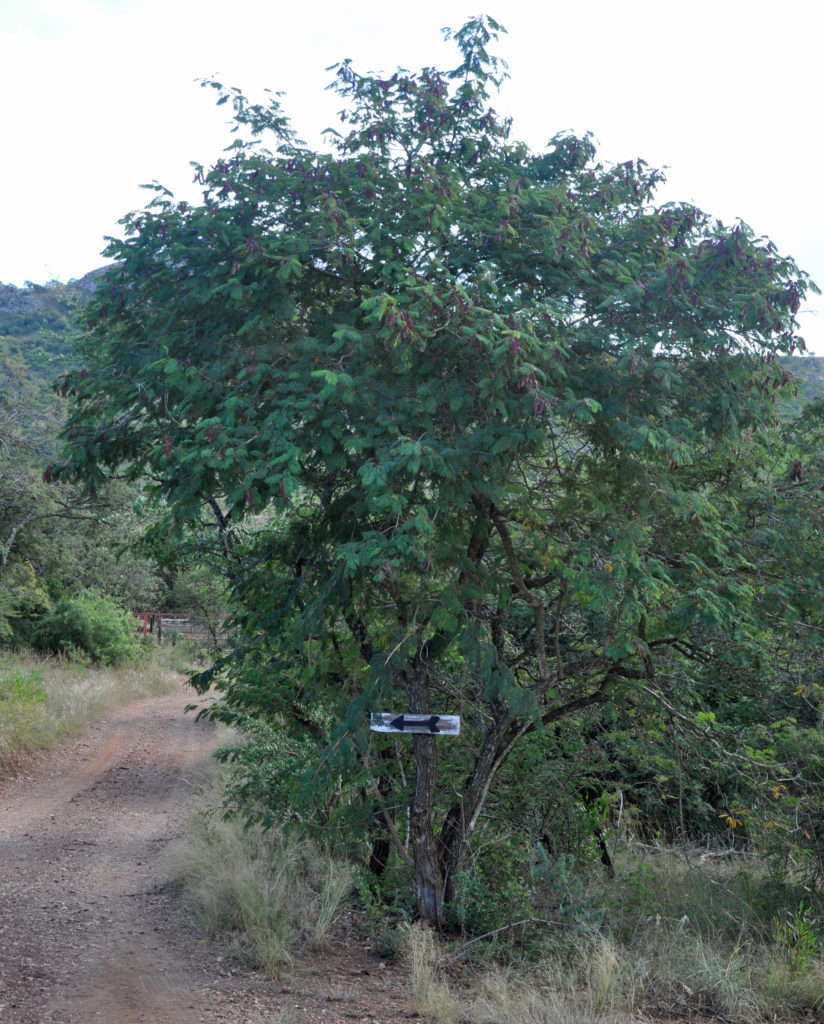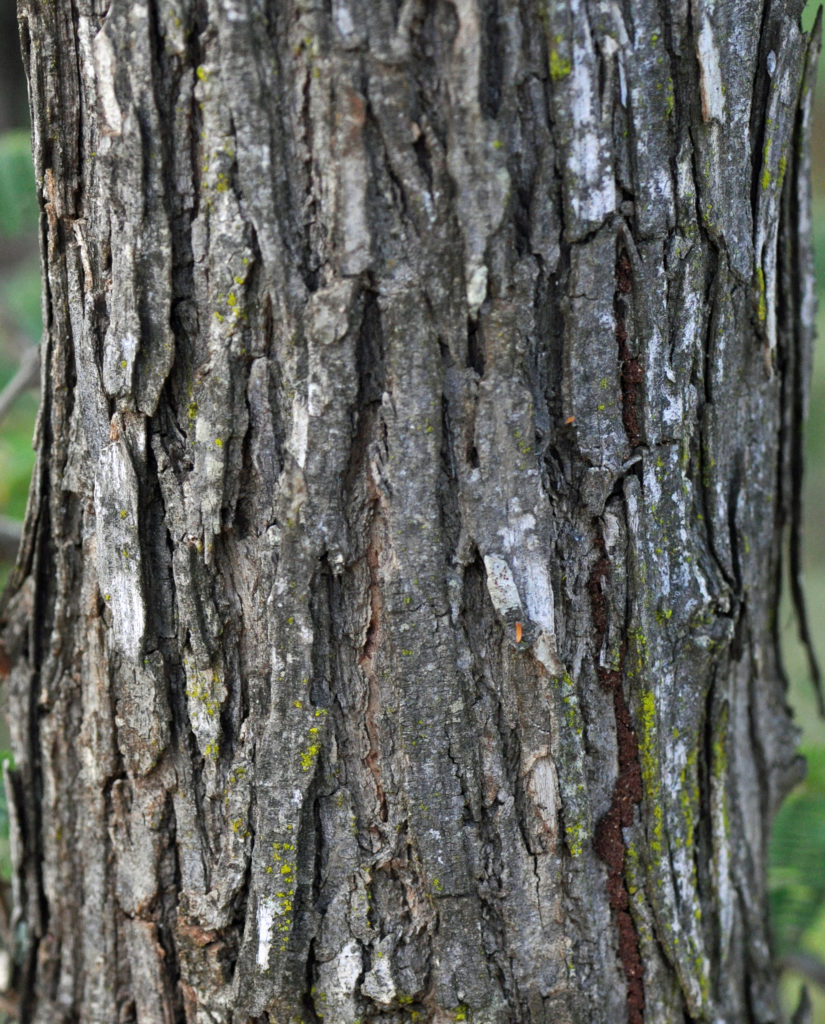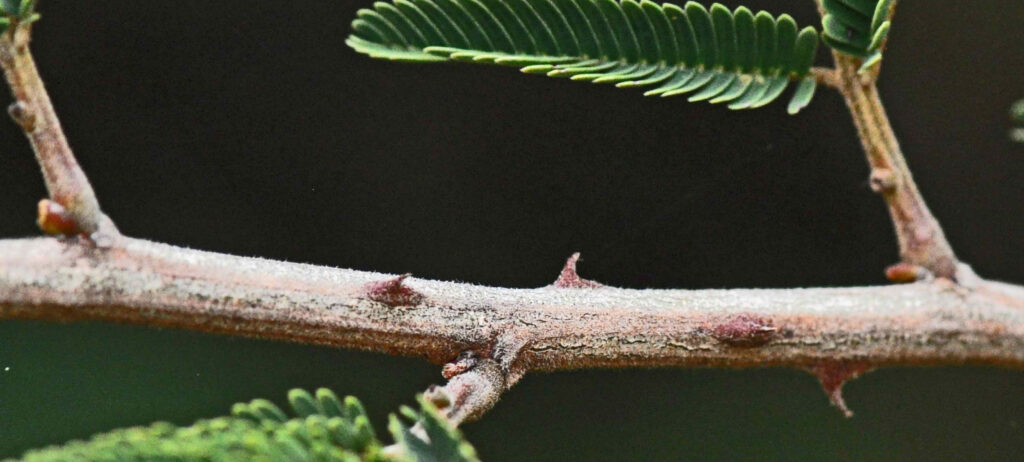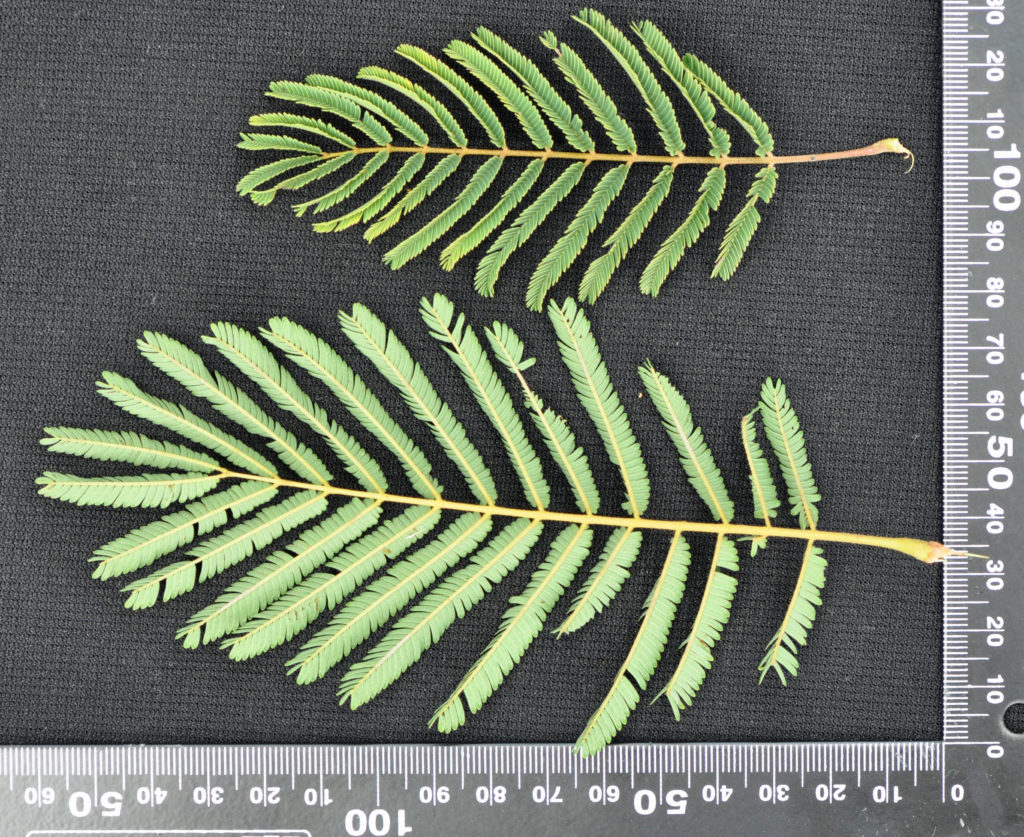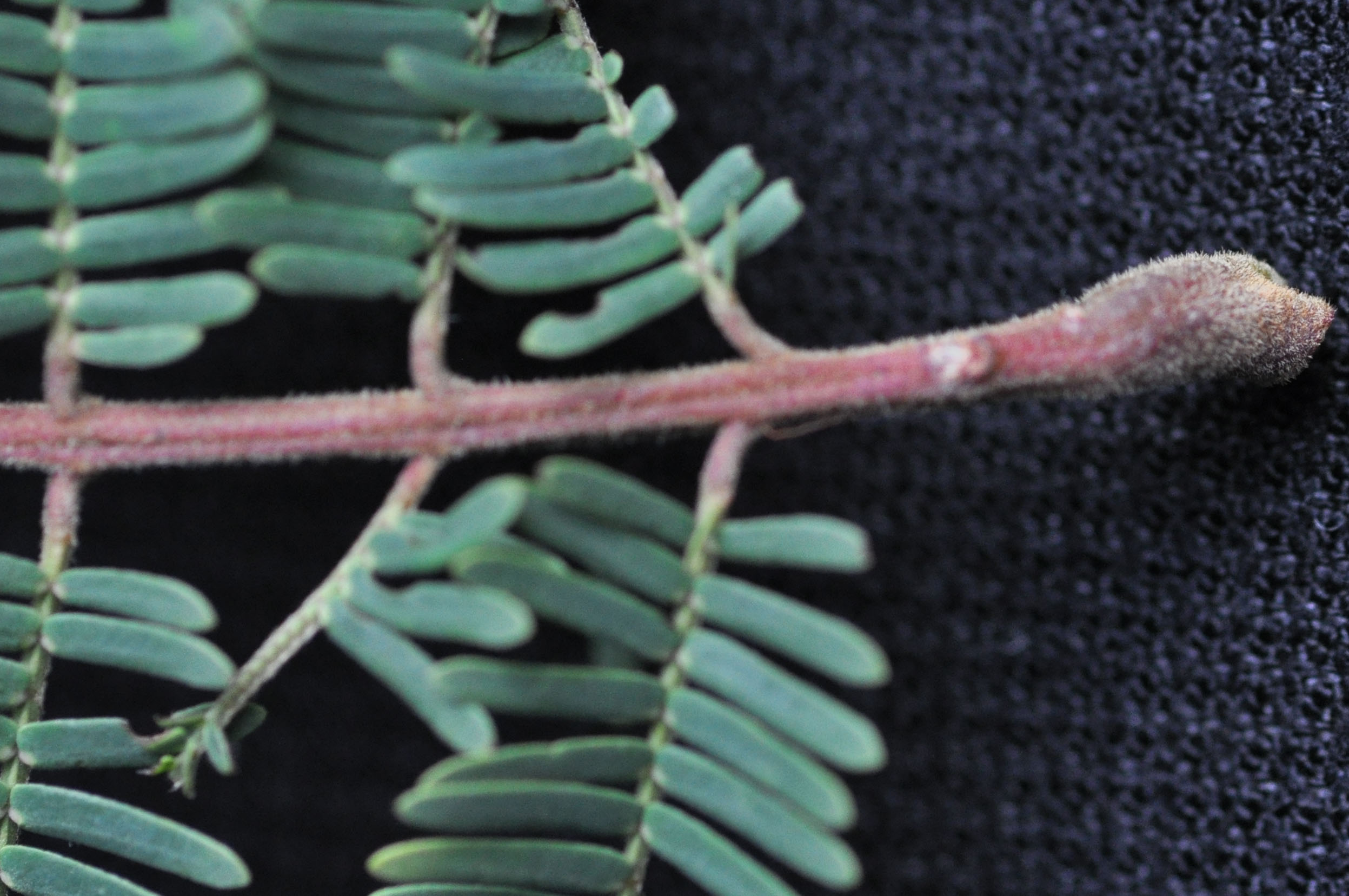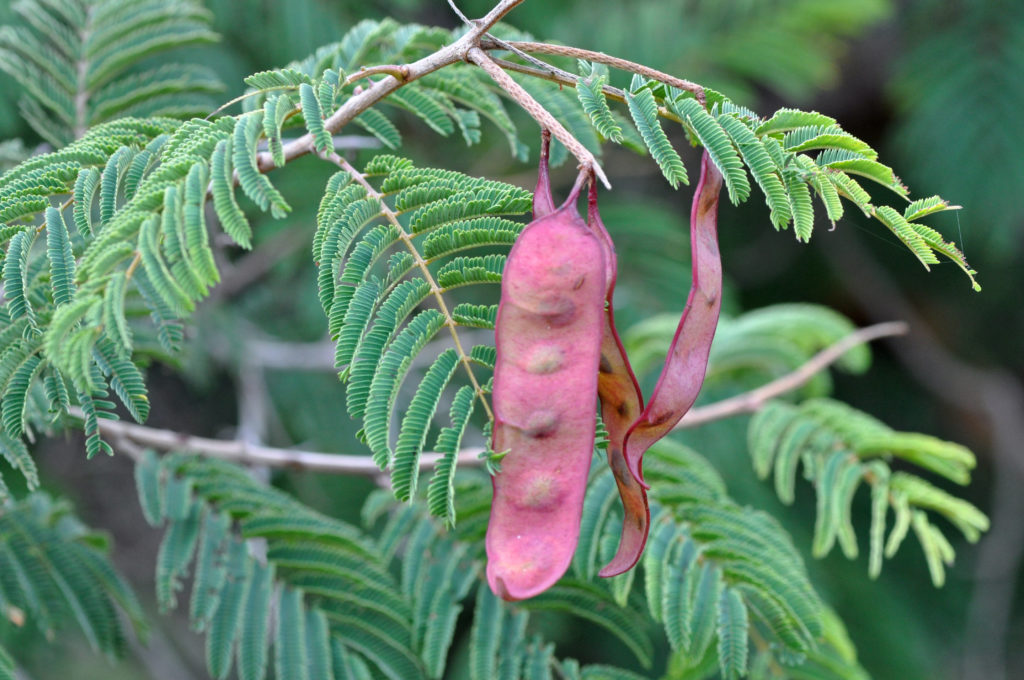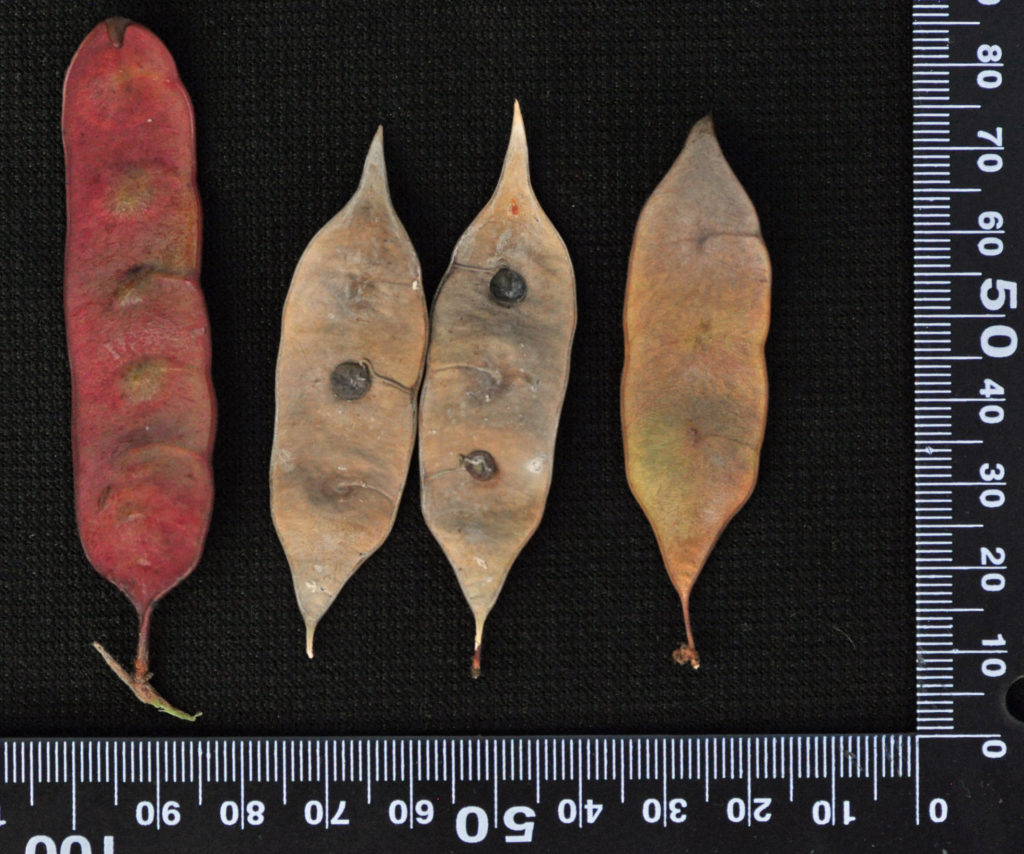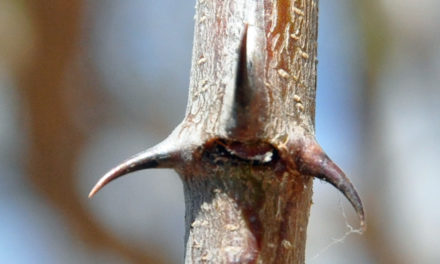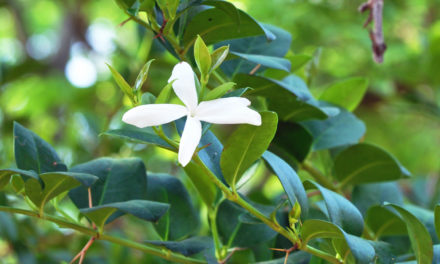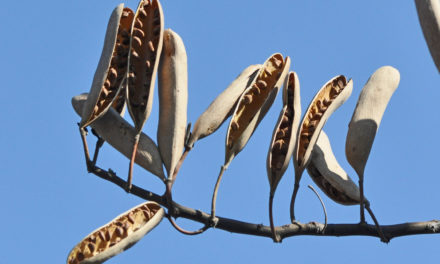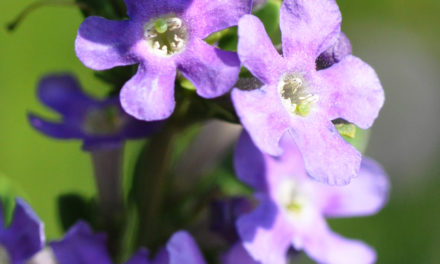General Info – summary
This Tree, with its longitudinally fissured bark, is up to 10+m high but is often a scrambling shrub. Single hooked thorns occur on young stems. Large bipinnate Leaves have tiny leaflets & spineless stipules. The tiny, fragrant, whitish Flowers are in spikes. Many exserted stamens give the flower colour. A superior ovary & thin style are present. The red then brown Fruit with 1-8 seeds & tapering at both ends is a pod.
Description
Senegalia ataxacantha
Previous Names: Acacia ataxacantha, Acacia eriadenia, Acacia lugardiae.
SA Tree No. 160.
Common names: (Afr) Vlamdoring, Rank wag-‘n-bietjie, Wag-‘n-bietjie. (Eng) Flame Acacia, Flame Thorn, Flamethorn. (Flame refers to the red fruits.) (isiXhosa) Umnga. (isiZulu) Ubophe, Ugagane, Umthathawe, Uthathawe. (Northern Sotho) Mogaletlwa, Mologa. (Setswana) Mogokare, Mogôkatau. (siSwati) Iugagane, Lugagane. (Tshivenda) Muluwa. (Tshivenda) Muluwa. (Xitsonga) Muluwa, Nuku.
Family: Fabaceae, or Leguminosae (Pea, bean or legume family). After the Orchidaceae and the Asteraceae, the Fabaceae is the third largest Angiosperm (flowering plants) family with 700+ genera and close to 20 000 species. Local Tree genera on this website include Acacia (Vauchellia, Senegalia), Albizia, Bauhinia, Bolusanthus, Burkea, Calpurnia, Colophospermum, Cordyla, Cyclopia, Dichrostachys, Erythrina, Erythrophleum, Faidherbia, Indigofera, Mundulea, Peltophorum, Philenoptera, Piliostigma, Schotia and Xanthocercis. The Fabaceae are recognisable by their fruit and by their pinnately compound Leaves. Leaves may also be simple – even bilobed and usually have stipules – some of which may be spinescent. Leaflets are usually entire. Flowers are bisexual and bracteate. Regular flowers usually have 4-5 sepals and the same number of petals. Irregular flowers have 4-5 sepals and 5 or less petals. Stamens have anthers that have 2 pollen sacs and there are usually at least twice the number of stamens as petals – often 10. The superior Ovary has 1 locule containing 1 or more ovules. The Stigma and Style are simple. The single carpel develops into the Fruit, which is usually a pod. The mature pods may dehisce or break into segments. Seeds vary.
Name derivation. Species of the genus Vachellia and Senegalia were considered members of the genus Acacia until 2005. New Names. The genus Vachellia was named after George H. Vachell (1789 – 1839), chaplain and plant collector in China. Here the inflorescence is capitate (head like) and spinescent stipules are present. Plants in the genus Senegalia – from Senegal (country in North West Africa) usually do not have spinescent stipules and the inflorescence is usually a spike. ataxacantha (Gk) – irregular/scattered thorns.
Conservation: National Status: L C. (Least Concern). Assessment: 2005 (W. Foden and L. Potter).
Tree
This Tree has a variable habit and may reach 3 to 15m high with a Stem (trunk) diameter of up to 30cm. The crown may be slightly rounded. In a forest, these scrambling trees often lean on local trees to assist with their quest for light. It is often a small untidy, woody, scrambling or climbing shrub, which can form impenetrable thickets. The main stem is up to 30cm wide and has flaking Bark that becomes rough and fissured longitudinally (photo 35). Old stems have distinctive, large swellings. The young stems may be reddish brown and pubescent (with soft hairs – photo 32). This scandent (climbing without the aid of tendrils) plant may use its thorns to assist in the process. The single (not in pairs) sharp, red to brown, hooked purplish to reddish brown Thorns are up to 1,5cm long and scattered among the branches – between nodes on unridged striations. These occur on a thickened base (photo 32) and do not develop from stipules but do help with tree identification.
- 39. 2017/04/30. Dream hills lodge. Photo: David Becking.
- 35. 2017/04/29. Dream Hills Lodge. Photo: David Becking.
- 32. 2017/04/29. Dream Hills Lodge. Photo: David Becking.
Leaves
This deciduous plant has fairly dense alternate Leaves up to 16cm long (photo 21) that are bipinnate (compound: twice-pinnate leaves). The Rachis (central axis) is grooved on the upper surface (photo 40), has lateral pinnae “branches” not leaflets, and the pinnules (Leaflets) are on these “side branches” – photo 21). There are 19-62 pairs of jugate (having leaflets in pairs) leaflets on each “side branch.” Each leaflet is up to 7 x 1,3mm. The mature dark green leaves tend to droop on the trees (photo 18 under Fruit). The small, bright to blue-green Leaflets may be slightly sickle-shaped (photo 40) and are up to 7 x 2,5mm. They may have an apical or basal tuft. One or two large distinctive petiolar glands protrude and may be present towards the middle of the upper surface of the Petiole (leaf stalk – photos 32 under Tree). Each gland is up to 2mm long. Glands are also present at the base of at least the top pair of pinnae. The petiole is usually up to 2,5cm long and the rachis (main axis) may be hairy (photo 40) or may have spines. The base of the petiole is swollen (photo 40). The Petiolules (stalks of leaflets) are very small (photo 40) and difficult to see. The large paired, peltate (shield-shaped) Stipules (basal appendages of the petiole) are not spinescent and fall early. There are no paired thorns at the leaf bases (as there are in Senegalia caffra). Small prickles may also occur on the underside of the rachis.
- 21 2017.04.29 Dream Hills Lodge. Photo: David Becking.
- 40. 2017/04/30. Dream Hills Lodge. Photo David Becking.
Flowers
The tiny, conspicuous, fragrant and creamy-white or yellow Flowers develop at branch ends in long Spikes (simple indeterminate inflorescence with sessile flowers on a single unbranched stalk). Each spike is up to 11cm long (the elongated remains of the spike stalk is visible just above the pod attachment in photo 18 under Fruit). The Calyx is very short. The Corolla is up to 3mm long. Both the calyx and corolla may be slightly hairy. The many free Stamens are up to 6mm long and exserted (sticking out; projecting) well beyond the Perianth (a collective term for the calyx and corolla). The Filaments (the usually long slender stalks that supports the anther) provide the creamy-white colour to the flowers. From the hairy superior Ovary emerges a filiform (thread or filament like) Style ending in a small, terminal Stigma (the part of the pistil that receives the pollen). (Oct-Feb).
Fruit
The distinct, attractive and straight Fruit is a flat dehiscent, longish Pod that is up to 20 x 2,5cm. It becomes semi translucent and initially a deep red (hence the common name of Flame Thorn) to maroon (photo 18) or purplish black. Mature brittle and slightly papery pods are brown and distinctly taper to sharp points at both ends (photo 36). Each longitudinally dehiscent pod contains up to 8 flattened olive-brown Seeds. Here the thin pod surface rises over the seeds. (Mar-Jul).
- 18. 2017/04/29. Dream Hills Lodge Photo: David Becking.
- 36. 2017/04/29. Dream Hills Lodge. Photo: David Becking.
Distribution & Ecology
In South Africa, these plants range from the Eastern Cape to Kwa-Zulu Natal, Gauteng and Limpopo as well as Mpumalanga and North-West. In Limpopo, the trees are common on the slopes of the Soutpansberg Mountains. They also occur in Swaziland, Mozambique, Botswana, Zimbabwe, west central Namibia and northwards as far as Senegal and Sudan. These trees grow in developing forests, in bushveld (is a sub-tropical woodland ecoregion of southern Africa) and dunes at medium altitude locations. In drier areas, they may be confined close to rivers. They are common around forest margins or even in open grasslands or rocky hillsides. They may develop impenetrable thickets – especially in disturbed areas. The tree is slightly drought resistant and is found up to an altitude of 2 000m. Crombecs (African warblers) and Wood hoopoes consume insects that are usually attracted to the flowers. The Leaden Hairtail (Anthene amarah amarah) butterflies are on the wing year-round. Their butterfly larvae feed on the leaves of Senegalia ataxacantha and many species of Vachellia. The leaves are also the food plant for the green larvae of the Satyr Emperor Charaxes butterfly (Charaxes ethalion ethalion). These larvae also feed on other plants including Dichrostachys cinerea, and Peltophorum africana.
Ethnobotany
The Wood can be split into the thickness of paper and provides a good weaving material – used in basket making. Split wood from the roots and stems is resistant to cracking when cut into fine strips. As a result, good quality baskets are made from them. The distinctive red-brown heartwood contrasts with the creamy white sapwood. Long-stemmed smoking pipes are made from the Roots. Before planting, the seeds should be soaked overnight in hot water. Once established, the plants are relatively frost hardy. This plant makes an efficient and hardy property boarder.
References
Boon, R. 2010. Pooley’s Trees of eastern South Africa. Flora and Fauna Publications Trust, Durban.
Burrows, J.E., Burrows, S.M., Lotter, M.C. & Schmidt, E. Trees and Shrubs Mozambique. Publishing Print Matters (Pty) Ltd. Noordhoek, Cape Town.
Coates Palgrave, M. 2002. Keith Coates Palgrave Trees of Southern Africa, edn 3. Struik, Cape Town.
Foden, W. & Potter, L. 2005. Senegalia ataxacantha (DC.) Kyal. & Boatwr. National Assessment: Red List of South African Plants version 2020.1. Accessed on 2023/12/12.
Lawrence, G. H. M, 1951. Taxonomy of Vascular Plants. The Macmillan Company, New York. Tenth Printing 1965.
Palmer, E. & Pitman, N. 1972. Trees of southern Africa. Balkema, Amsterdam, Cape Town.
Ross, J. H. A conspectus of the African Acacia Species. 1979. Botanical Research Institute.
Schmidt, S. Lotter, M. & McCleland, W. 2002. Trees and Shrubs of Mpumalanga and the Kruger National Park. Jacana, Johannesburg
van Wyk, B. & van Wyk, P. 1997 Field guide to Trees of Southern Africa. Struik, Cape Town.
http://www.plantzafrica.com/plantab/acaciaataxa.htm
https://en.wikipedia.org/wiki/Senegalia_ataxacantha
http://posa.sanbi.org/flora/browse.php?src=SP
http://www.zimbabweflora.co.zw/speciesdata/species.php?species_id=125790
https://plants.jstor.org/compilation/Acacia.ataxacantha

